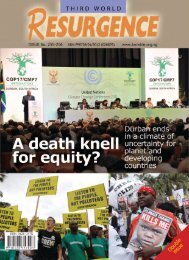Plantations, poverty and power - Critical Information Collective
Plantations, poverty and power - Critical Information Collective
Plantations, poverty and power - Critical Information Collective
Create successful ePaper yourself
Turn your PDF publications into a flip-book with our unique Google optimized e-Paper software.
10<br />
immune system damage <strong>and</strong> skin diseases.<br />
Before Celulosa Arauco y Constitución (CELCO) built the Valdivia pulp mill the Cruces River wetl<strong>and</strong>s<br />
were home to about 6,000 black necked swans. Pollution from the mill killed hundreds of black necked<br />
swans. The company denies that it is responsible, but the evidence is against the company. “They should<br />
have never built the plant there in first place,” a World Bank consultant said at an industry conference in<br />
Brazil in May 2006. 14<br />
In September 2007, the Chilean State Defence Council (CDE) filed a US$3.9 million lawsuit against<br />
CELCO for the company’s pollution of another river, after 20,000 cubic metres of untreated industrial<br />
waste was released from CELCO’s Licancel pulp mill. The waste water polluted the Matauito River,<br />
where it resulted in the death of thous<strong>and</strong>s of fish. 15<br />
Pollution from Asia Pulp <strong>and</strong> Paper’s Indah Kiat pulp mill in Sumatra has killed the fish in the Siak<br />
River, destroying the livelihood of people living along the river. A few years ago, German film-maker<br />
Inge Altemeier travelled with Trabani Rab, a medical professor who has been monitoring the impacts of<br />
Indah Kiat’s mill on villagers’ health for several years. In two days of visiting villages on the Siak River,<br />
he diagnosed more than 500 cases of serious skin diseases. 16<br />
It is not only in the South that pulp mills are polluting. In 2005, World Rainforest Movement’s<br />
international coordinator, Ricardo Carrere, visited Finl<strong>and</strong> to find out for himself just how clean pulp<br />
production in Finl<strong>and</strong> actually is. While the pulp industry is not as polluting as it once was, neither it is by<br />
any means pollution-free. In 2003, 7,500 cubic metres of black liquor leaked from UPM’s Kaukas pulp<br />
mill into Lake Saimaa. Within a few days the black liquor had spread far into the lake. Half of the fish<br />
biomass in the lake was wiped out in a three-kilometre radius area from the pulp mill. 17<br />
Leonel’s presentation is just one example of the propag<strong>and</strong>a produced by the pulp <strong>and</strong> paper industry to<br />
justify its expansion in the global South. To explain why the industry is so keen on exp<strong>and</strong>ing in the<br />
South, we need to look at some of the processes <strong>and</strong> actors involved in promoting industrial tree<br />
plantations.<br />
Building the political framework<br />
In many countries in the global South, the first step towards building the political framework for a<br />
massive expansion of the pulp <strong>and</strong> paper sector was a national forestry plan. Many of these were written<br />
as part of the Tropical Forestry Action Plan which was established in the mid-1980s, as the world became<br />
increasingly concerned about the fate of the tropical forests. Set up by the World Bank, the United<br />
14 The consultant was Neil McCubbin <strong>and</strong> he said this in May 2006 at RISI’s Latin American Pulp <strong>and</strong> Paper Outlook<br />
Conference in Brazil. http://pulpinc.wordpress.com/2006/10/02/world-bank-consultant-says-celcos-valdivia-mill-shouldnever-have-been-built-there/<br />
15 “CDE sues Celco for Licancel plant contamination”, BNamericas.com, 11 September 2007.<br />
http://www.tmcnet.com/usubmit/2007/09/11/2929455.htm<br />
16 Chris Lang (2005) “Indonesia: The health impacts of living near Indah Kiat’s pulp <strong>and</strong> paper mills”, WRM Bulletin no. 97,<br />
August 2005. http://chrislang.org/2005/08/27/indonesia-the-health-impacts-of-living-near-indah-kiats-pulp-<strong>and</strong>-papermills/<br />
17 Ricardo Carrere (2005) “On the pulp trial in Finl<strong>and</strong>: the other side of the coin”, Group Guayubira, June 2005.<br />
http://www.guayubira.org.uy/celulosa/Finl<strong>and</strong>ia.html















